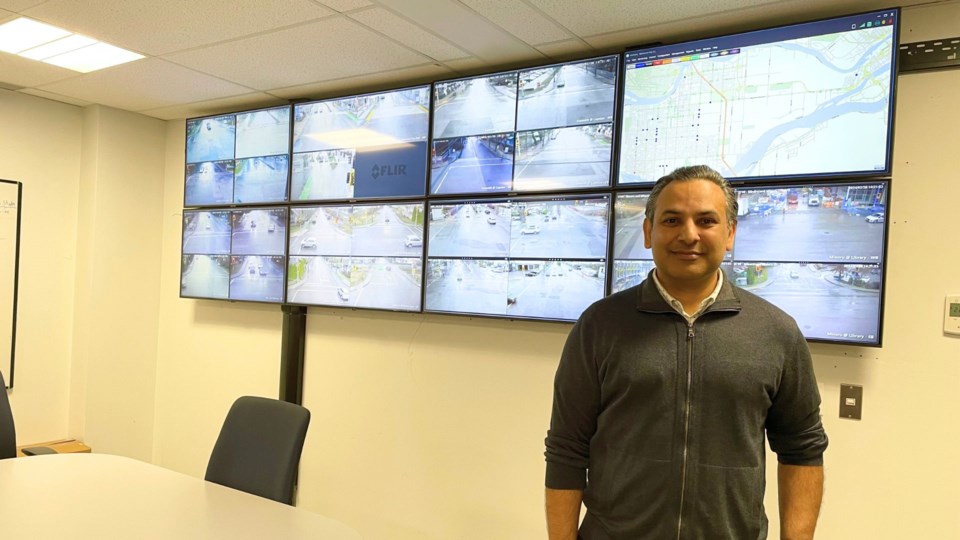Eight television screens and a team of four is what keeps the traffic lights and cameras running every day across Richmond.
The team, which works out of the city’s Traffic Management Centre near city hall, is led by supervisor of traffic signal systems Bill Johal who has been working with the transportation department for more than 20 years.
Richmond has about 335 devices such as crosswalk buttons and road sensors that affect traffic lights across the city as well as more than 500 cameras to help the team monitor for issues.
“We do the design, maintenance, operation and construction, so we oversee the entire fold of the traffic signal system,” said Johal.
His passion for traffic signals hasn't dwindled since he started working with the city.
“I really (enjoy) the technology aspect of it and everything that goes along with the system.”
On a day-to-day basis, the city’s traffic team monitors the camera and light system for malfunctions in real-time.
“We’re constantly alerted on our computers and phones because it is a high liability if the signals don’t do what they're supposed to do,” said Johal.
Traffic light system viewed on a dotted map
Among the eight screens in the office is one that displays all the traffic lights, marked as coloured dots, across the city.
For example, green shows the lights and the system in the area are working and red signals an issue with the system at a particular intersection.
At the control centre, the traffic lights are synchronized first thing in the morning and in the early afternoon.
So, at these times, as long as drivers are following the speed limit, they can ride “a green wave.”
In off-times, however, the traffic lights go into “free mode.”
This means when a pedestrian or a vehicle arrives at an intersection, the traffic light will react faster as opposed to being on a coordinated system to manage traffic flow during busier hours.
Johal cleared up one of the biggest myths about traffic sensors: a car sitting on the back sensor of a left-turn lane doesn't automatically trigger a left-turn arrow.
Rather, all the sensors have to be occupied with at least three to five vehicles in the lane, in order for an arrow to be triggered.
“We don’t want to give an arrow to one car. You can’t game the system,” said Johal.
Furthermore, there are zones in between special intersections, such as railway tracks, that trigger a longer green light to move cars through the area.
These road and light sensors have been upgraded over the years to improve traffic arrangements.
When asked what he found most interesting part of the job, Johal said seeing all the technological advancements that have come in since he first started in the transportation department.
“We can manage and communicate to every single device out (on the road) - that wasn’t around about 20 years ago,” he said.
Furthermore, catering foremost to vehicles is no longer the top priority.
Signal timing used to focus largely on vehicles, but in the past five to 10 years pedestrian and cyclist signals have moved up in priority, Johal said.
Traffic cameras require appropriate infrastructure
There are around 550 intersection cameras at 148 intersections in Richmond tied to the traffic signal system.
While there have been some unusual sightings on the traffic cameras, Johal said the most common issue they see is drivers with a “flagrant disregard for the rules.”
“We’ve definitely seen people completely blow off red lights and cause all kinds of trouble,” he said.
“And, unfortunately, sometimes that leads to fatalities.”
Many requests for video evidence are for people running a red light – the biggest infraction the traffic management team has seen.
Johal added when one person runs a red light, sometimes three or four vehicles follow.
When asked how the city determines which intersection gets traffic cameras, Johal explained that they need to be connected to underground fibre optic cables to send strong signals back to the traffic management centre.
So, those areas that already have fibre optic cables are where cameras have been installed and the city is “coming around and looking at other corridors.”
The plan, he added, is to have cameras at all intersections that have traffic lights, but it comes down to infrastructure and costs for more camera installations.
“Cameras might not be available in less populated areas right now, but we’re working on building out the system in the next five to seven years.”
Got an opinion on this story or any others in Richmond? Send us a letter or email your thoughts or story tips to [email protected].




